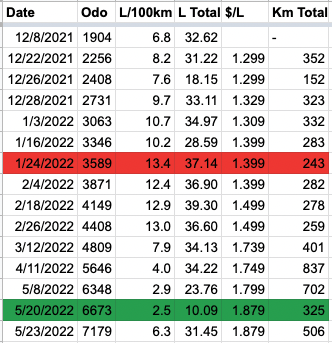Seven months ago I wrote a blog post with some of my initial thoughts and reasoning behind buying a Hyundai Santa Fe PHEV. I have been keeping detailed fuel economy records since December 8th, in attempt to quantify and understand its gasoline usage over time.

Above is the screenshot of my spreadsheet. Due to COVID travel restrictions and continued work from home, the majority of this data is running errands inside the city. Two exceptions being two trips to Riding Mountain Nation Park, at the end of December and the weekend of the 20th.
During the winter months, I was having mixed feelings about my decision. As things have warmed up, I’m getting more optimistic.
Mysterious Algorithm
The algorithm that determines when to engage the gasoline engine is confounding.
Below -20C the engine always engages, in fact the system displays a warning message informing you that it’s too cold to drive in electric mode. I suppose this makes a certain amount of sense since battery performance is very poor at very cold temperatures, as well the engine needs to warm its oil if it’s going to run at all. So I suppose it is “priming” the engine and providing additional heating during these times.
Above roughly +15C the engine never engages.
At temperatures in between, the engine status seems highly dependent on whether or not you’ve got the cabin heat on. The heat seems to be drawn from the engine like a traditional car (and not from a fully electric heat pump, like I was hoping). In temperatures, above -10 or so the engine does eventually stop once enough heat has been built up.
But there are other times, that the engine engages seemingly at random. It’s quite frustrating. Even turning off the heat won’t guarantee that the engine will turn off.
Sometimes when the engine is running for no apparent reason (i.e. relatively warm outside, no heat needed inside) turning the car off and on again seems to kick the car into EV mode. But not always.
As frustrating as that is, even during these periods the batteries are propelling the car, the engine only runs at an idle. So fuel usage is still low.
In fact, the engine almost never goes above idle RPM, except in “sport” mode or if you floor it.
Cold Weather Fuel Economy Sucks
Winnipeg experienced on of the coldest winters on record this year.
You can see this reflected in the data above. The worst fuel economy was mid January at 13.4L/100km. While this is utterly disappointing for a car capable of full EV, I’d expect this is not worse than a non-hybrid Santa Fe during similar temps.
The interesting thing about the characteristics of the EV algorithm is that at these super cold temps, your fuel economy actually increases the further you drive. I think this is due to the fact that the engine is mainly idling so it’s burning a constant amount of fuel while you’re continuing to drive further and faster without using any more fuel.
Warm Weather = Full EV
Based on what I’ve seen in May (if we didn’t take any road trips) I wouldn’t expect to buy more than one tank of gas this entire summer.
At temperatures above 15C the gas engine stays off 98% of the time. It does still randomly engage occasionally for short periods of time (perhaps to charge the DC battery?). And also sometimes when getting up to speed quickly.
I am very pleased by this warmer weather performance.
Conclusions
I fully expect the summer driving on electricity to outweigh the poor performance during this extremely cold winter. If next winter is closer to seasonal I’d expect to say below 9L/100km even in January. The fuel savings should only add up over time.
If you need a vehicle, a PHEV is a great transitional vehicle while the electric infrastructure gets built out. Even in the coldest Winnipeg winter.